Military places order for 13 new F-35 fighter-bomber aircraft in $1.27 billion deal
PATUXENT RIVER NAS, Md., 4 May 2016. U.S. military air combat leaders are ordering 13 F-35 jet fighter-bomber aircraft of various configurations from Lockheed Martin Corp. under terms of a $1.27 billion contract announced Monday.
The F-35 with its advanced avionics is a fifth-generation single-seat, single-engine, all-weather stealth multirole jet fighter-bomber designed to perform ground attack, aerial reconnaissance, and air defense missions. It is one of the most advanced combat jets in the world.
Officials of the U.S. Naval Air Systems Command at Patuxent River Naval Air Station, Md. -- the organization handling F-35 aviation technology procurement for all military forces -- are ordering conventional and vertical takeoff and landing versions, as well as carrier versions of the F-35 jet from the Lockheed Martin (NYSE:LMT) Aeronautics segment in Fort Worth, Texas.
The order involves three F-35A conventional takeoff and landing (CTOL) jet aircraft for the U.S. Air Force that operate from conventional long runways; six F-35B short takeoff and vertical landing (STOVL) jet aircraft for the U.S. Marine Corps that operate from ships and unimproved runways; and four F-35C reinforced aircraft for the U.S. Navy with folding wings for aircraft carrier operations.
Related: F-35 combat jet: only time will tell if current problems will become long-term deficiencies
The F-35 is designed to replace U.S. F-16, A-10, F/A-18, and AV-8B tactical fighter and attack aircraft. Lockheed Martin has been developing the F-35 since 2001.
The aircraft has had a technologically troubled history, with problems reported in the jet aircraft's radar system, software, and logistics subsystems. The aircraft also has suffered from numerous cost overruns and production delays.
The single-seat F-35 military jet is 50.5 feet long, has 35-foot wingspan, and is 14 feet tall. It has one Pratt & Whitney F135 afterburning turbofan engine that can produce as much as 43,100 pounds of thrust.
The aircraft can fly as fast as Mach 1.6, can fly as high as 50,000 feet, and has a range of 1,200 miles. It has one 25-millimeter Gatling gun and can carry a variety of advanced air-to-air missiles, air-to-ground missiles, smart bombs, and conventional bombs.
Related: The F-35 joint strike fighter's turbulent march to combat readiness
The F-35's avionics includes the Northrop Grumman AN/APG-81 AESA radar; Lockheed Martin AAQ-40 electro-optical targeting system (EOTS); Northrop Grumman AN/AAQ-37 distributed aperture system (DAS) missile warning system; BAE Systems AN/ASQ-239 electronic warfare (EW) suite; and Northrop Grumman AN/ASQ-242 communications and navigation system.
The plane's navigation and communications include the Harris Corp. Multifunction Advanced Data Link (MADL); Link 16 data link; single-channel ground and airborne radio system (SINCGARS); IFF interrogator and transponder; HAVE QUICK radio; AM, VHF, UHF AM, and UHF FM radio systems; GUARD survival radio; radar altimeter; tactical air navigation (TACAN); instrument landing system for conventional runways and aircraft carriers; the Joint Precision Approach and Landing System (JPALS); and the TADIL-J tactical digital information link with Joint-Variable-Message-Format (JVMF) communications.
F-35 pilots wear a helmet-mounted display that enables them simply to look at a target to shoot weapons, rather than pointing the entire aircraft at the target. The orientation of the pilot's head provides missile seeker heads with targeting information.
The combat aircraft -- one of the most expensive military weapon systems in history -- is designed to perform ground attack, aerial reconnaissance, and air defense missions. Last July the first squadron was declared ready for deployment. U.S. military leaders say they plan to buy 2,457 aircraft.
Related: Pentagon reduces F-35 joint strike fighter production amid defense budget cuts
The F-35 variants are intended to provide the bulk of the manned tactical air power of the U.S. Air Force, Navy, and Marine Corps. Deliveries of the F-35 for the U.S. military are scheduled to be completed in 2037.
On this order Lockheed Martin and its partners will do the work in Fort Worth, Texas; El Segundo, Calif.; Warton, England; Orlando, Fla.; Nashua, N.H.; Baltimore; and Cameri, Italy, and should be finished by December 2019.
For more information contact Lockheed Martin online at www.f35.com, or Naval Air Systems Command at www.navair.navy.mil.

